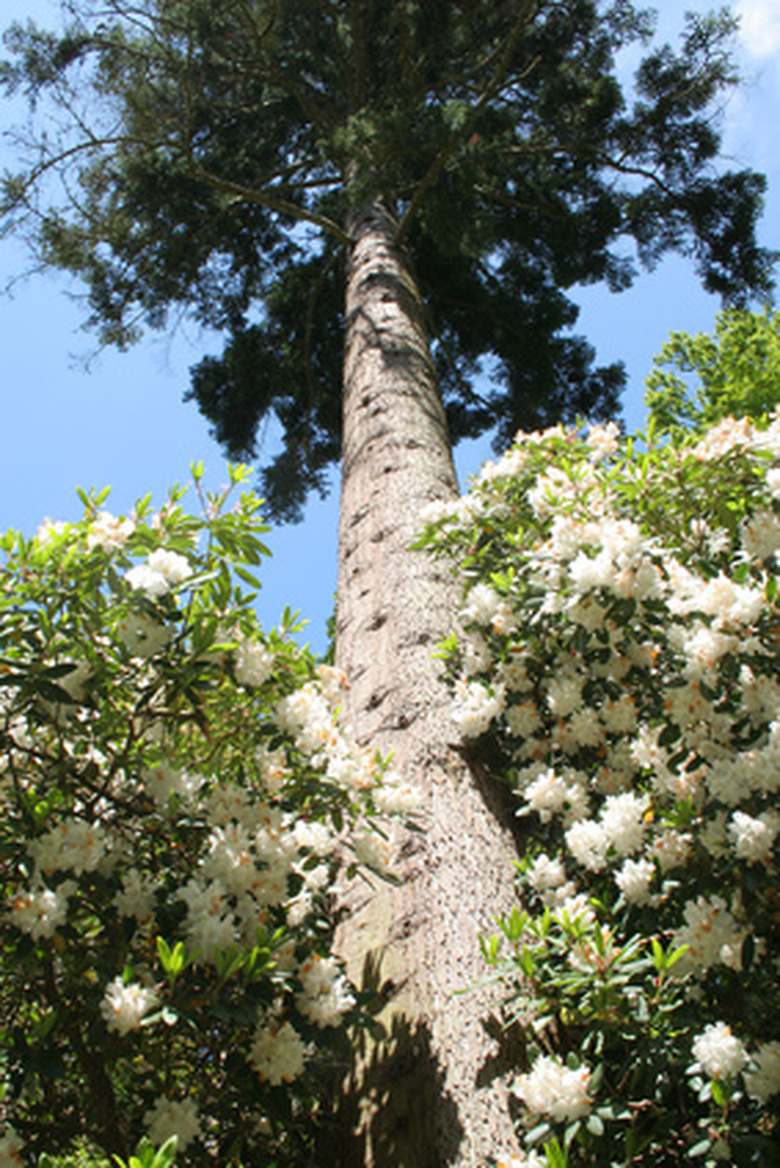Ten Examples Of Shrubs
Shrubs are woody plants generally smaller and more compact than trees. To the landscaper, shrubs offer myriad uses, from single items of interest to components of screens and hedges. Shrubs vary greatly in size and shape, and different species offer diverse seasonal interests, from flowers and fall foliage to winter berries.
Azalea
Azaleas are related to rhododendrons but display minor differences in leaf and flower structure. Nicknamed the "royalty of the garden," over 10,000 named cultivars of azaleas exist, providing the gardener with myriad options in terms of color, pattern and bloom time. In North America, azaleas are deciduous, dropping their leaves in the fall, and tend to bloom in late spring.
Rhododendron
Rhododendrons belong to the heath family and are closely related to heather, blueberries and mountain laurels. Rhododendron is a broad classification that includes more than 1,000 species, including azaleas. Although popular garden plants and grown throughout the world today, most rhododendrons originated in Asia, particularly in the Himalayan foothills.
- Shrubs are woody plants generally smaller and more compact than trees.
- Azaleas are related to rhododendrons but display minor differences in leaf and flower structure.
Butterfly Bush
Butterfly bushes grow as large shrubs–some species reach heights of 15 feet–with distinct clusters of colorful, scented flowers that attract butterflies. Each flower is tiny with a golden center, although the color of the petals varies, ranging from dark purple and red to white. In mild climates, butterfly bushes are semi-evergreen.
Rose-of-Sharon
Rose-of-Sharon grows as an upright shrub with brightly colored, showy flowers. Because rose-of-Sharon flowers in the summer when many other shrubs have long shed their blossoms, gardeners often use the shrub to provide summer interest in a garden. Rose-of-Sharon may reach heights of 10 feet and is easy to care for and transplant.
Forsythia
When spring arrives, forsythia shrubs dominate the landscape and provide one of the season's first bursts of color. Forsythia produces bright yellow flowers that are so hardy that, when the snow melts away in northern regions, it often reveals the colorful bush beneath. After its three-week bloom period, forsythia fades into the landscape, becoming an ordinary green shrub.
- Butterfly bushes grow as large shrubs–some species reach heights of 15 feet–with distinct clusters of colorful, scented flowers that attract butterflies.
- Because rose-of-Sharon flowers in the summer when many other shrubs have long shed their blossoms, gardeners often use the shrub to provide summer interest in a garden.
Hydrangea
Hydrangea produce large, round clusters of pink, white and blue flowers. Although there are 23 species of hydrangea, only about five are commonly planted in gardens in the United States. Some hydrangeas develop blossoms with multiple colors, sometimes even within the same flower cluster. Blossom color in hydrangeas is determined, in part, by the soil pH and availability of aluminum.
Barberry
Barberry are able to tolerate hot climates and dry soils, making them easy to care for and suitable for southern landscaping uses. Some barberry shrubs are deciduous, producing colorful leaves in the fall and bright red berries that persist into the winter, and others are evergreen. Barberry shrubs also produce long thorns.
- Hydrangea produce large, round clusters of pink, white and blue flowers.
- Some hydrangeas develop blossoms with multiple colors, sometimes even within the same flower cluster.
Juniper
Juniper ranges in size from plants low and spreading enough to serve as ground cover to full-sized evergreen trees. In the middle, gardeners can find juniper plants suitable for use as shrubs and hedges. Juniper is an evergreen plant, though the foliage of different species develops in different shades of green, and some species produce berries.
Weigela
The red trumpet-shaped flowers of weigela, also known as the cardinal shrub, popularized it in Europe when it first arrived from Asia in the mid-19th century. Today, selective breeding has produced cultivars with blossoms in pink, red and white and leaves in a variety of hues. Although weigela only blooms naturally in the spring, other cultivars extend the blooming season through the summer.
Lilac
Lilacs produce brilliantly colored flowers in white, pink or purple and are prized for their strong, pleasant fragrance. Although some lilacs grow as small trees, other cultivars have more compact growth and are appropriately used as shrubs. Typically, lilacs blossom in May, although other cultivars have adjusted or extended the growing season.
- Juniper ranges in size from plants low and spreading enough to serve as ground cover to full-sized evergreen trees.
- Although some lilacs grow as small trees, other cultivars have more compact growth and are appropriately used as shrubs.
